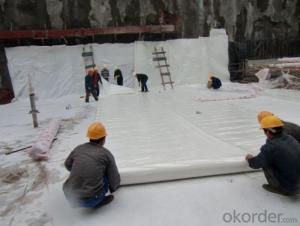HDPE Self-adhesive Waterproof Membrane 1.2mm
- Loading Port:
- China Main Port
- Payment Terms:
- TT or LC
- Min Order Qty:
- 5000 m²
- Supply Capability:
- 100000 m²/month
OKorder Service Pledge
OKorder Financial Service
You Might Also Like
HDPE Waterproof Membrane Introduction:
HDPE Self-adhesive Waterproof Membrane is specially used in underground project, it can bond with concrete layer tightly. After Membrane bonding with concrete, water can be blocked between membrane and concrete, which can improve the reliability.
HDPE Waterproof Membrane Applications:
Basement,Subway,Tunnel Cave, Other underground public constructions.
HDPE Waterproof Membrane Advantages:
1. Good bonding with concrete applied on membrane, to block water between membrane and concrete further to protect concrete effectively.
2. Low flatness requirement to substrate, reliable overlapping; mechanical fixing, easy application.
3. Sound anti-puncture performance.
4. Adaptable to settlement and distortion.
5. Weather-resisting and anti-UV.
6. Resist to acid, alkali, mold.
7. Eco-friendly material
HDPE Waterproof Membrane Specifications:
| Width(m) | Length(m) | Thickness(mm) |
| 1.2 or 2.4 | 20 or more | 1.2 or 1.5 |
FAQ:
Q: What kind of payment way your company accept?
A: TT, LC, etc
Q: Can I do the third party testing before loading?
A: Yes, we could accept the third party testing.
Q: Which kind of payment in your company?
A: We could accept TT, LC at sight, etc.
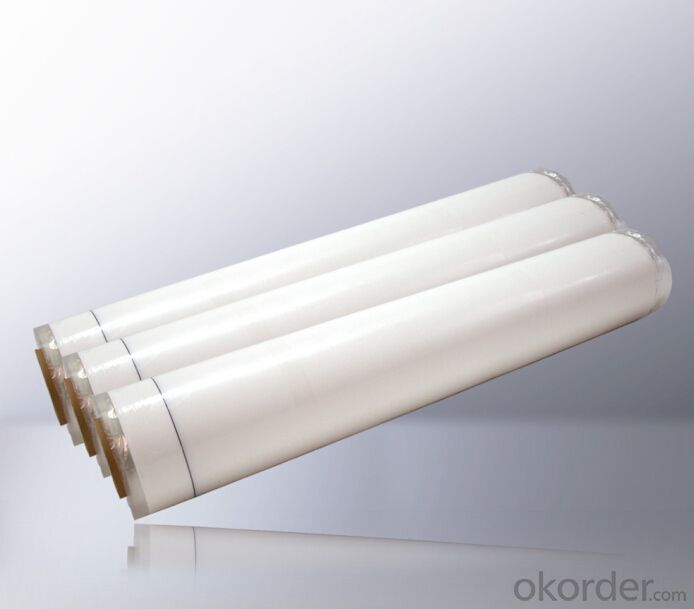
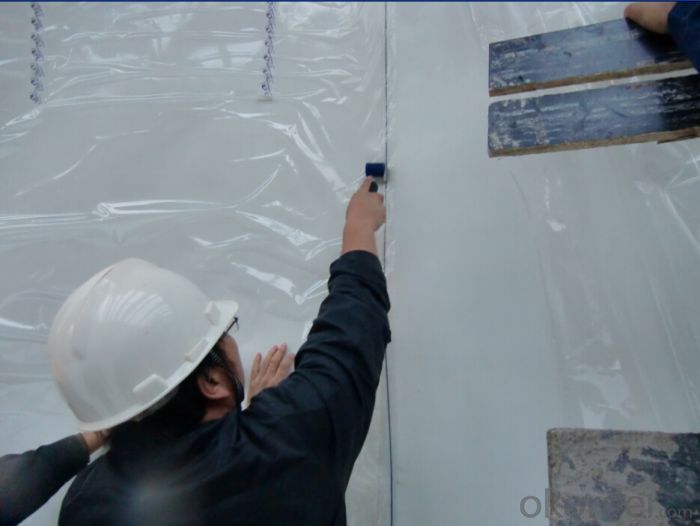
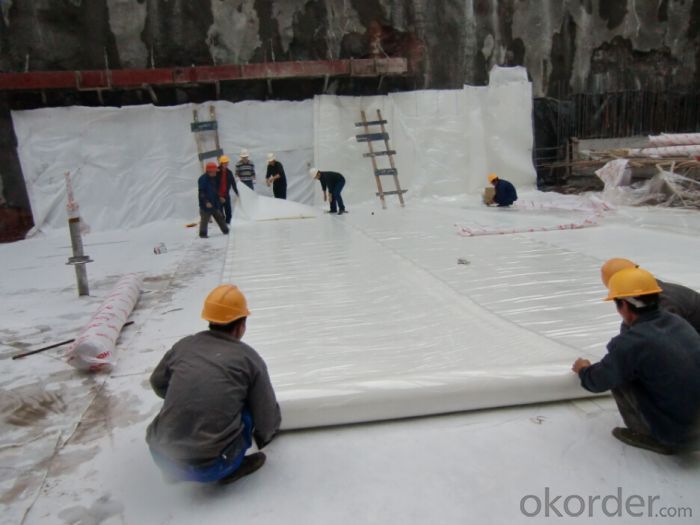
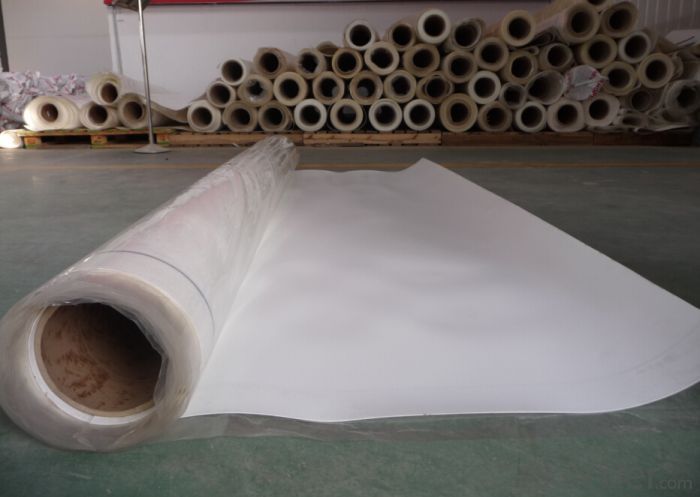

- Q:Are there any specific considerations for installing a waterproofing membrane on masonry surfaces?
- Yes, there are several specific considerations for installing a waterproofing membrane on masonry surfaces. Firstly, it is important to ensure that the masonry surface is clean and free from any dirt, debris, or loose materials that could compromise the adhesion of the membrane. Additionally, the surface should be properly prepared by repairing any cracks, holes, or damaged areas before applying the membrane. The type of waterproofing membrane chosen should be compatible with masonry surfaces and be able to withstand the movement and expansion that can occur. Proper installation techniques, such as ensuring sufficient overlap and proper sealing of joints, are also crucial to ensure effective waterproofing. Lastly, regular inspections and maintenance should be conducted to identify any potential issues and address them promptly.
- Q:Can a waterproofing membrane be applied on top of roofing materials?
- Yes, a waterproofing membrane can be applied on top of roofing materials. It is common practice to install a waterproofing membrane on top of roofing materials to provide an additional layer of protection against water infiltration and extend the lifespan of the roof.
- Q:How does a waterproofing membrane compare to other waterproofing methods?
- A waterproofing membrane is highly effective in preventing water intrusion compared to other waterproofing methods. It forms a continuous barrier that is resistant to water penetration, protecting the underlying structure from moisture damage. Unlike other methods like sealants or coatings, a membrane offers superior durability and flexibility, ensuring long-term waterproofing performance. Additionally, membranes are easy to install and can cover large areas efficiently, making them a preferred choice in various construction projects.
- Q:Can a waterproofing membrane be used on metal block surfaces?
- Yes, a waterproofing membrane can be used on metal block surfaces. Waterproofing membranes are designed to create a barrier against water and moisture, and they can be applied to a variety of surfaces, including metal. The membrane will adhere to the metal surface, creating a waterproof layer that helps prevent water infiltration and protect the metal from rusting or corrosion. However, it is important to ensure that the metal surface is clean, dry, and properly prepared before applying the waterproofing membrane to ensure proper adhesion and effectiveness. Additionally, it is recommended to consult with a professional or refer to the manufacturer's instructions for specific guidance on using a waterproofing membrane on metal block surfaces.
- Q:Can a waterproofing membrane be used in historic buildings?
- Yes, a waterproofing membrane can be used in historic buildings. However, it is important to consider the specific needs and requirements of the building. The use of a waterproofing membrane should be carefully assessed and integrated into the building's preservation and conservation plans to ensure compatibility with its historic fabric and materials. Professional advice and expertise should be sought to ensure the appropriate selection and installation of the waterproofing membrane without compromising the building's historic integrity.
- Q:Can a waterproofing membrane be used for zoos or aquariums?
- Yes, a waterproofing membrane can be used for zoos or aquariums. Waterproofing membranes are designed to provide a protective barrier against water infiltration and can be an effective solution for preventing water damage and leakage in these types of environments. They can be applied to various surfaces, such as concrete or steel, to create a watertight seal and prevent water from seeping into the structure or habitat. Waterproofing membranes are often used in aquariums to ensure that the tanks remain water-tight and do not leak, which is crucial for the well-being of the aquatic animals. Similarly, in zoos, waterproofing membranes can be used in animal enclosures or exhibit areas to prevent water damage to the structures and maintain a safe and healthy environment for the animals. Additionally, the membranes can also protect against potential chemical spills, as they are often resistant to various chemicals and can withstand harsh conditions. Overall, waterproofing membranes are a suitable option for zoos or aquariums as they provide an effective solution for maintaining the integrity of the structures and habitats, preventing water damage, and ensuring the safety and well-being of the animals.
- Q:Can a waterproofing membrane be used on aluminum surfaces?
- Yes, a waterproofing membrane can be used on aluminum surfaces. Waterproofing membranes are versatile and can be applied to various types of surfaces, including aluminum. These membranes are designed to provide a protective barrier against water and moisture, preventing leaks and water damage. Applying a waterproofing membrane on aluminum surfaces can help extend the lifespan of the material by protecting it from corrosion and rust caused by water exposure. However, it is important to ensure that the waterproofing membrane chosen is compatible with aluminum and suitable for the specific application to achieve optimal results.
- Q:Are there any specific considerations for installing a waterproofing membrane on sloped surfaces?
- Yes, there are several specific considerations for installing a waterproofing membrane on sloped surfaces. Here are a few important ones: 1. Proper slope: It is crucial to ensure that the slope of the surface is appropriate for drainage. The slope should be designed to allow water to flow away from the surface and prevent any pooling or ponding. This will help in avoiding water penetration and potential damage to the membrane. 2. Compatibility with slope materials: It is important to consider the compatibility of the waterproofing membrane with the materials used on the slope. This includes ensuring that the membrane adheres well to the slope surface and does not react negatively with any other materials present. 3. Anchoring and fastening: On sloped surfaces, proper anchoring and fastening of the waterproofing membrane is important to ensure its stability and longevity. This may involve using additional mechanical fasteners or adhesives specifically designed for sloped surfaces. 4. Transition and edge details: Sloped surfaces often have transition areas or edges where the waterproofing membrane meets other surfaces, such as walls or adjacent slopes. These areas require specific attention to ensure a proper seal and prevent any water infiltration. 5. Drainage systems: Sloped surfaces may require the installation of additional drainage systems to effectively manage water runoff. This may include the use of drains, gutters, or downspouts to divert water away from the waterproofing membrane. 6. Quality of installation: Installing a waterproofing membrane on a sloped surface requires careful attention to detail and proper installation techniques. It is important to follow the manufacturer's instructions and industry best practices to ensure a successful and durable installation. Overall, installing a waterproofing membrane on sloped surfaces requires a thorough understanding of the unique challenges and considerations involved. By addressing these specific factors, you can ensure effective waterproofing and protection for your sloped surface.
- Q:Can a waterproofing membrane be used on balconies and decks?
- Yes, a waterproofing membrane can be used on balconies and decks. Waterproofing membranes are specifically designed to provide a protective layer against water damage, making them an ideal solution for outdoor areas like balconies and decks that are exposed to rain, snow, and other moisture. By applying a waterproofing membrane, you can effectively prevent water penetration, enhance the durability of the surface, and extend the lifespan of your balcony or deck.
- Q:Can waterproofing membranes be used on utility manholes?
- Utility manholes can indeed benefit from the use of waterproofing membranes. These specialized membranes are specifically engineered to create a barrier against water infiltration, making them perfectly suited for areas where water is present, such as manholes. To prevent any potential damage to the structure or the utilities within, these membranes are typically applied to the walls and floors of the manhole, effectively preventing water from seeping through. This process not only maintains the integrity and functionality of the utilities, but also helps to avoid water-related issues like corrosion, leaks, and material degradation. Furthermore, waterproofing membranes offer additional protection against elements such as chemicals, gases, and soil contaminants that may be found in or around the manhole. Thus, the application of waterproofing membranes on utility manholes is a widely adopted practice to guarantee their long-term durability and functionality.
1. Manufacturer Overview |
|
|---|---|
| Location | |
| Year Established | |
| Annual Output Value | |
| Main Markets | |
| Company Certifications | |
2. Manufacturer Certificates |
|
|---|---|
| a) Certification Name | |
| Range | |
| Reference | |
| Validity Period | |
3. Manufacturer Capability |
|
|---|---|
| a)Trade Capacity | |
| Nearest Port | |
| Export Percentage | |
| No.of Employees in Trade Department | |
| Language Spoken: | |
| b)Factory Information | |
| Factory Size: | |
| No. of Production Lines | |
| Contract Manufacturing | |
| Product Price Range | |
Send your message to us
HDPE Self-adhesive Waterproof Membrane 1.2mm
- Loading Port:
- China Main Port
- Payment Terms:
- TT or LC
- Min Order Qty:
- 5000 m²
- Supply Capability:
- 100000 m²/month
OKorder Service Pledge
OKorder Financial Service
Similar products
New products
Hot products
Hot Searches
Related keywords


